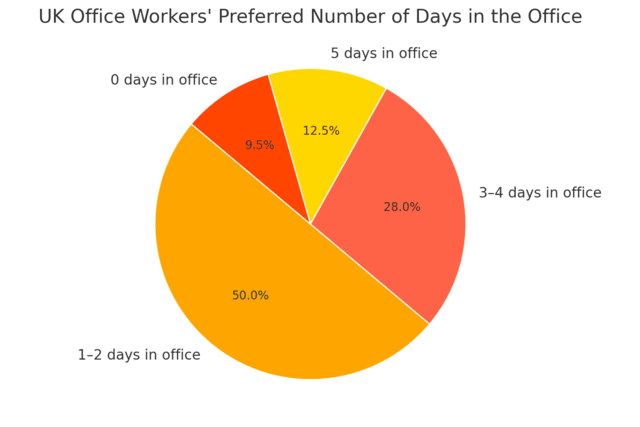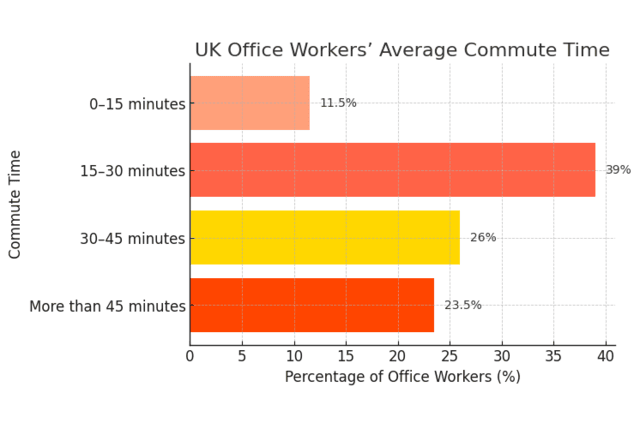
Survey Summary: UK Office Workers’ Perspectives on Returning to the Office
Five years after the onset of the pandemic that transformed the world of work, the dynamics of office life are still getting readjusted. According to a 2024 survey, more than 80% of British chief executives foresee a full return to the office within 3 years – but how do employees view this?
To find out, we polled 400 office workers of private and public sector employers on this hot topic and asked about their preferences and concerns as they transition from remote work back to the office. Here are the key findings.
Who’s Actually Back in the Office?
Our UK survey reveals that a majority of respondents (57%) have returned to the office on a part-time or hybrid working basis at their employer’s request, while 43% are back full-time. These figures confirm that in-person office work has taken over remote work as the new normal, although there’s a substantial shift towards flexible models.
Takeaway: “Flexible office work isn’t a trend—it’s the new standard”
The Office is No Longer a 5-Day Commitment
The CIPD Labour Market Outlook for Autumn 2024 showed that the most common arrangement is 3 mandated days in the office for companies in both the private and public sector. And at 2.7 days per week, central London offices have the lowest mandatory return-to-the-office rates compared to other global cities like Paris, New York, or Sydney. How does this all fare against employee preferences?

When asked about their ideal number of office days, 50% said they prefer 1-2 days in the office. An additional 28% favour 3-4 days a week, while only 12.5% want to be in the office full-time. This points to a clear preference for a low in-person commitment.
Takeaway: “Hybrid wins. Offering hybrid working options can be a decisive factor in keeping your workforce motivated”
Where Are UK Workers Most Productive?
Poll answers are inconclusive: although half of the respondents feel more productive working remotely, 27.5% favour the office for productivity, and around 22% said there’s no difference in productivity levels.
This suggests that barriers to productivity exist regardless of the work arrangement. Distractions, inadequate layouts, lack of privacy, and poor ergonomics can happen in the home office and in the company office.
Takeaway: “It’s time to get clear on how your work environment affects productivity”
What Perks Do UK Office Workers Care About?
Perks promoting work-life balance and convenience lead the way, with our poll showing that flexible hours and free or subsidised meals/snacks are the most highly valued perks.
Other high-ranking amenities include subsidised or reimbursed travel expenses, additional training or professional development opportunities, more options to socialise with coworkers, free car parking, and on-site cafes or restaurants. The lowest-ranking perks are end-of-trip facilities (like bike storage, showers, changing rooms, etc.), on-site childcare, and gym facilities.
Understanding what perks are truly valued is crucial for employers looking to optimise space usage and increase office attendance. Previous trends in office design heavily focused on physical perks like gyms, end-of-trip facilities, and kitchen or catering facilities to entice employees back. However, our poll suggests a shift in how employers should approach office utilisation, to create a workplace that genuinely supports a collaborative culture and the evolving needs of the workforce.
Takeaway: “Forget the office ping-pong table—today’s workers want perks that make work worth the commute”
Speaking of which …
Time, Money, and the Real Cost of Commuting
In 2024, the average commute in the UK was 15-29 minutes. This is consistent with our survey, where 39% of respondents commute 15-30 minutes, 26% travel for 30-45 minutes, and more than 23% spend over 45 minutes commuting. Only 11.5% have a short commute under 15 minutes.

We all know that time is money, and the longer the commute, the more financial pressure this puts on employees. Our poll reveals that 48.5% of workers are spending up to 5% of their income on commuting costs, and more than 34% spend 10% of it. At the upper end of the scale, 2% spend 20% of their income or more getting to and from the office.
A further 6% don’t spend anything commuting – we guess this bracket includes office workers who walk, cycle, or have transport covered by their employer. This is not uncommon among London office workers, as cycling has experienced a 140% uptake compared to pre-pandemic levels.
Takeaway: “The commute is an integral part of the employee experience. Are you considering ways to optimise it for your office workers?”
Flexibility: Genuine Support or Just a Buzzword?
A substantial 70.5% of respondents said that their company supports flexible work arrangements, while nearly 30% feel their employers are not supportive. This suggests that while many business leaders and organisations are incorporating flexibility in a tangible way, there’s still room for improvement.
Takeaway: “Be intentional and action-oriented when rethinking flexible work policies and ensure you offer tools and resources instead of just rules and guidelines”
The Mental Health Impact of Returning to the Office
Despite generally feeling supported by their employers, going back to the office after months or even years of working from home is a big change that can affect employees’ mental well-being. In our poll, 31.5% report a positive impact, while 23.5% feel negatively affected.
Takeaway: “Almost a quarter of employees struggle after returning to the office. Ensure your company policy addresses the diverse mental health needs of employees”
Are UK Workers Happy Going Back to the Office?
With this poll, we really wanted to get to the bottom of UK employees’ views of the return to the office. So how satisfied are they with their current work arrangement?
64% of respondents said they were either satisfied or somewhat satisfied, while more than 17% were very pleased. However, 38% were not enthusiastic about returning to the office, including 5% who were very dissatisfied.
Takeaway: “More than a third of employers aren’t happy going back to the office. It’s time to open up the discussion on how to improve employee satisfaction”
RTO Mandates: Watch Out for Staff Turnover
Enforced return-to-office (RTO) mandates have led 37% of formerly remote workers to consider changing jobs, which points to significant resistance in the workforce. Poll respondents also commented on their views of these mandates, and more than half (58%) don’t believe that these policies improve company culture. Not only that, but 30.5% have observed higher turnover rates at their workplaces since mandates came into effect.
Takeaway: “Mandating office returns without flexibility may have unintended consequences, eroding company culture and increasing turnover”

Conclusion
Our poll results confirm it: the office isn’t dead, but outdated attendance policies might be. While UK bosses may be pushing for full return to the office mandates, employees have clearly expressed their preference for hybrid and flexible working models, cost-saving perks, and meaningful workplace benefits. The future of office work isn’t about enforcing attendance, but rather about creating an environment that employees actually want to return to.
Employers looking to encourage a return to the office may need to reconsider how they can make their office environment more appealing and supportive to meet the diverse preferences of their workforce. The data from our poll can point both small and large employers in the right direction when it comes to adapting their office spaces so they benefit both their staff and the company’s bottom line.
Searching for cutting-edge, inviting offices in London?
If the aforementioned has motivated you to move to a more contemporary workspace where office design, amenities, and location convenience are the main focus, there are plenty of possibilities in Central London and Greater London boroughs that showcase the best office design trends to engage your employees to create high performing teams.
A new workspace could be a wise investment for your company, regardless of your needs. We offer an extensive range of office spaces to satisfy the needs and goals of any business. For a talk with one of our commercial property specialists, please call 020 3965 9617. Our knowledgeable advisors are here to assist you in finding the perfect London office space that suits your unique requirements.
Do you want to read more?
For additional information and advice on making your head office a welcoming place for returning workers, insights on the workplace in general, or other hot topics in London’s business world, see some of our other recent articles below.
Office Christmas Party Ideas: Not the Traditional, Boozy ‘Do
The Most Haunted Places in London, England: Office Buildings Edition
Gen Z in the Workplace: A Comprehensive Guide
The Benefits of Having Plants in the Office
Cycling to Work in London: Bike-Friendly Office Locations
London Office Market Report 2024
Office Design Trends in Central London Office Space
New Developments in London Office Space: Central
